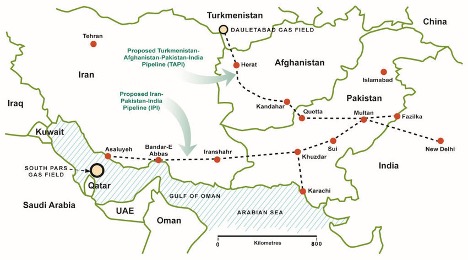
by Awais Abbasi 8 February 2023
South Asia has historically struggled with regional connectivity due to weak infrastructure, harsh political realities, and the region’s small share of global trade (5%). Due to this low level of trade and economic activity, South Asia has been categorized by the World Bank as one of the least interconnected areas in the world.
Afghanistan has a long history of serving as a crucial junction between several ancient civilizations. The nation is at the geographic crossroads of Central Asia, South Asia, and the Middle East, serving as a hub for connection in Asia.
Afghanistan can play a crucial role in regional and international politics because it is known as the “heart of Asia” and shares cultural customs and traditions with these areas. This is especially true in light of worries about a new “great game” narrative and the growing alignment between China and Russia.
Central Asia, South Asia, and the Middle East are all connected by Afghanistan, making it a geopolitically significant yet unstable region. Ironically, present initiatives to improve connection are more likely to separate South Asian governments from one another than to bring them together.
India is pursuing projects to its east, and Pakistan is looking for chances in Afghanistan and Central Asia as part of new infrastructure plans that are being implemented in sub-continent. The next battleground for India and Pakistan’s rivalry is this infrastructural development.
Due to their strategic orientation and claims to political space, India and Pakistan are very intimately connected to Afghanistan, to the point where if something negative occurs in one of the three nations, it will affect the other two. Because of this, the current situation in Afghanistan has significant ramifications for the entire region, not just in terms of their foreign policy goals but also for the area’s long-term security, peace, advancement, and stability.
The connectivity initiatives of both Pakistan and India confront difficulties. Even though the war in Afghanistan is over, continued terrorist threats and the country’s economic woes continue to be major roadblocks to infrastructure development. Political unrest in Central Asia also exists. Financing is still an issue. Border conflicts are another difficulty.
The improvement of ties between India and Pakistan is necessary for South Asian connectivity initiatives to be genuinely regional, but this is not likely to happen anytime soon. Broader regional integration may not be practicable for some time, making sub regional connectedness the best result now available.
Geographical focus on Pakistan makes sense from a practical and geopolitical standpoint. Afghanistan’s infrastructure development faces less security threats now that the conflict there has officially ended. The Taliban have in the past supported international infrastructure initiatives, such as TAPI. Growing diplomatic ties between Pakistan and Russia may aid it in navigating Central Asia, where Moscow wields significant sway and Islamabad competes with New Delhi.
If NATO had persisted, trade routes through a semi-stable Afghanistan might have been developed, creating opportunity for Afghans. Since the Taliban are now in charge and no other nations have recognized them as the legitimate administration, it is now up to local leaders to establish economic connections throughout Afghanistan.
India is currently focused on the other side of South Asia. It has pushed integration by taking advantage of its participation in the Bay of Bengal Initiative for Multi-sectorial Technical and Economic Cooperation (BIMSTEC). With the exception of Pakistan, BIMSTEC consists of Myanmar and Thailand and five South Asian nations. Designs for interconnected electrical networks are provided by recent BIMSTEC agreements. India has also granted permission for other nations to utilize its system, leading to agreements with Bangladesh and Nepal to share power.
India’s move towards the east also appears to be tactical. Any ambitions for India to be connected to the west are limited by Pakistan’s refusal to grant it transit trade privileges. New Delhi has less sway in Kabul now that the Taliban rule Afghanistan.
If Central Asia and South Asia are to escape the gravitational pull of Russia and China, connectivity between the two areas is necessary. Since many important economic projects require stability in Central Asia, which borders Afghanistan, have built relationships with the Taliban administration.
The strong bilateral ties and economic cooperation that already exist must be further strengthened through high-level engagements, particularly in the domains of trade, energy, and connectivity.
